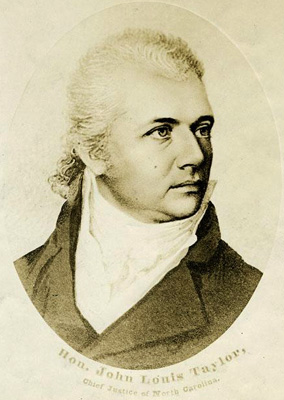1 Mar. 1769–29 Jan. 1829

John Louis Taylor, chief justice and legislator, was born in London of Irish parentage. Orphaned, he came to America at age twelve with an older brother, James, who helped finance his studies at William and Mary College, Williamsburg, Va. For lack of funds, he left school before graduation and settled in North Carolina, where he studied law by himself without a tutor. Admitted to the bar in 1788, he began practicing in Fayetteville. In 1790 he was an unsuccessful candidate for the post of state solicitor general, to be appointed by the General Assembly. Five years later he also failed in his application to be North Carolina's attorney general. Meanwhile, in 1792 he was a presidential elector and was sent to the 1792 House of Commons by the borough town of Fayetteville. He was reelected in 1794 and 1795. The next year he moved to New Bern.
In 1798 the Assembly named him a judge of the superior courts. Under an 1810 act the other judges in July 1811 chose him as their presiding officer or so-called "chief justice." This necessitated his moving to Raleigh. He sold his home at New Bern and in Raleigh built a residence, Elmwood, about 1813. In 1822 he opened "the first place for legal education in North Carolina which might be called a law school." When the Supreme Court of North Carolina was established, Taylor became on 1 Jan. 1819 its first chief justice, a position he retained until his death.
Taylor was the first reporter of the state supreme court and published several volumes of its decisions. The author of textbooks and other works, he was a member of a commission to revise the state's statutes. From 1793 to 1818 he was a trustee of The University of North Carolina. Georgetown University conferred on him the honorary doctor of laws degree. A Federalist in politics, he was an orator of note. He opposed the importation of enslaved people as part of the trans-Atlantic slave trade and supported measures to encourage trade and improve the administration of justice.
While residing at Fayetteville Taylor joined Phoenix Lodge, Ancient Free and Accepted Masons, and was one of its two delegates to the Grand Lodge Communication there in December 1793. He was elected junior grand warden and the next year was advanced to senior grand warden.
At New Bern he affiliated with St. John's Lodge. In 1799 he was made deputy grand master, an office he held for two years. In 1802, at age thirty-three, he became grand master and was twice reelected. He was the 1807 worshipful master of St. John's Lodge and from 1814 to 1817 served again as grand master. Taylor worked diligently and spoke frequently in behalf of Masonic principles. When he retired from the grand mastership, two lodges were named for him. Portraits of him were hung in the headquarters of the Grand Lodge of North Carolina at Raleigh and the Masonic Temple at New Bern.
Taylor's first wife was Julia Rowan, by whom he had one daughter, Julia Rowan. After her death he married, on 16 Aug. 1797, Jane Gaston, by whom he had a son, John L., and a daughter, Margaret Ann. He bequeathed his Raleigh home to his brother-in-law, William Gaston, who lived there until his own death.
Taylor was also an enumerated enslaver. The numbers of people he enslaved varied throughout his life. In 1790, when Taylor lived in Fayetteville, he was listed as the enslaver of one person in the 1790 census. According to the 1800 census, John L. Taylor of New Bern was the recorded enslaver of 18 people.
Taylor died on January 29, 1829, at his Raleigh home. He was buried at the Oakwood Cemetery in Raleigh.